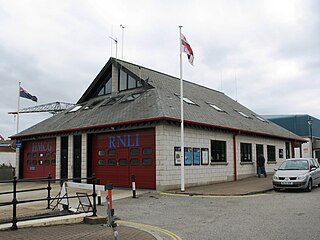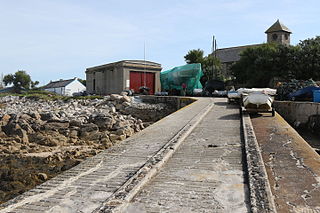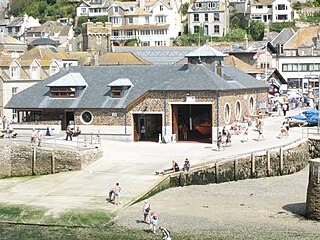
St Mary's is the largest and most populous island of the Isles of Scilly, an archipelago off the southwest coast of Cornwall in England, United Kingdom.

Porthleven is a town, civil parish and fishing port near Helston, Cornwall, England, United Kingdom. The most southerly port in Great Britain, it was a harbour of refuge when this part of the Cornish coastline was infamous for wrecks in the days of sail. The South West Coast Path from Somerset to Dorset passes through the town. The population at the 2011 census was 3,059.

Mersey-class lifeboats are All-weather lifeboats operated by the Royal National Lifeboat Institution (RNLI) from stations around the coasts of Great Britain and Ireland, with three former RNLI boats operated by ADES Uruguay, and one by Bote Salvavidas de Valparaiso, Chile. They are capable of operating at up to 17 knots (31 km/h) and can be launched from a carriage or by slipway.

Coverack is a coastal village and fishing port in Cornwall, UK. It lies in the parish of St Keverne, on the east side of the Lizard peninsula about nine miles (14 km) south of Falmouth.

Porthoustock is a hamlet near St Keverne in Cornwall, England, United Kingdom, on the east coast of Lizard Peninsula. Aggregates are quarried nearby and Porthoustock beach is dominated by a large concrete stone silo that was once used to store stone ready to load ships but is now disused. Coastal trading ships of up to 82 metres can dock alongside the pier along the southern edge of the beach to be loaded with stone. Fishing boats operate from the pebble beach, with lobster and crab potting, net fishing and hand lines as the principal fishing methods. The South West Coast Path passes through Porthoustock.

The Lizard Lifeboat Station refers to several Royal National Lifeboat Institution lifeboat stations located on the Lizard in Cornwall, United Kingdom. The first was established at the southernmost point of the peninsula in 1859. Since then successive stations have all been in operation at different locations on The Lizard. The current station is located at Kilcobben Cove 0.5 mi (0.80 km) east of the village of Lizard.

Falmouth Lifeboat Station is the base for Royal National Lifeboat Institution (RNLI) search and rescue operations at Falmouth, Cornwall in the United Kingdom. The first lifeboat was stationed in the town in 1867 and the present station was opened in 1993. It operates a Severn Class all-weather Lifeboat (ALB) and an Atlantic 85 inshore lifeboat (ILB).

Fowey Lifeboat Station is the base for Royal National Lifeboat Institution (RNLI) search and rescue operations at Fowey on the south coast of Cornwall in the United Kingdom. The first lifeboat was stationed in the area in 1859 and the present station was opened in 1997. It operates a Trent Class all weather boat (ALB) and a D class (IB1) inshore lifeboat (ILB).

St Ives Lifeboat Station is the base for Royal National Lifeboat Institution (RNLI) search and rescue operations at St Ives, Cornwall in the United Kingdom. The first lifeboat was built for the town in 1840 and the present boathouse was opened in 1994. It operates a Shannon-class All-weather boat (AWB) and a D-class (IB1) inshore lifeboat (ILB).

Ilfracombe Lifeboat Station is the base for Royal National Lifeboat Institution (RNLI) search and rescue operations at Ilfracombe, Devon, England. The first lifeboat was stationed in the town in 1828 and the present station was opened in 1996. For 29 years a second boat was operated from Morte Bay at Woolacombe.

Burnham-on-Sea Lifeboat Station is the base for Royal National Lifeboat Institution (RNLI) search and rescue operations at Burnham-on-Sea, Somerset in England. A lifeboat was stationed in the town from 1836 until 1930. The present station was opened in 2003. It operates two inshore lifeboats (ILBs), a B-Class rigid-inflatable boat and an inflatable D-Class.

Penlee Lifeboat Station is the base for Royal National Lifeboat Institution (RNLI) search and rescue operations for Mount's Bay in Cornwall, United Kingdom. The lifeboat station operated at various locations in Penzance from the early 19th century. It moved to Penlee Point near Mousehole in 1913, thus gaining its current name, but was moved to Newlyn in 1983 without any change of name. The station is remembered for the loss of the entire lifeboat crew on 19 December 1981.

Sennen Cove Lifeboat Station is the base for Royal National Lifeboat Institution (RNLI) search and rescue operations for the sea around Land's End, Cornwall in the United Kingdom. The first lifeboat was stationed at Sennen Cove in 1853. Since 2009 it has operated a Tamar-class all weather boat (ALB) and a D-class (IB1) inshore lifeboat (ILB).

Fishguard Lifeboat Station in located on the quay, at the northern breakwater of Fishguard Harbour, in the community of Fishguard and Goodwick, in the county of Pembrokeshire, Wales.

The Watson-class lifeboat is a design of wooden lifeboat operated by the Royal National Lifeboat Institution (RNLI) around the coasts of the United Kingdom and Ireland between 1888 and 1991. There were several variations over the years but all the boats had hulls that conformed to a design by George Lennox Watson, the RNLI's naval architect from 1887 until his death in 1904.

St Agnes' Lifeboat Station was situated in St Agnes, Isles of Scilly and provided a service for the Royal National Lifeboat Institution from 1890 to 1920. The lifeboat station and slipway still exist, and have been identified by the Isles of Scilly Council as a Building of Local Significance.

St Agnes Lifeboat Station was opened in 1968 and is based in St Agnes, Cornwall, South West England. It is operated by the Royal National Lifeboat Institution (RNLI). Until 2015 the station's lifeboats were sponsored by BBC TV's Blue Peter programme and named Blue Peter IV.

Penzance Lifeboat Station was the base for Royal National Lifeboat Institution (RNLI) operations in Mount's Bay in Cornwall, United Kingdom. The first lifeboat to be placed at Penzance was in 1803 but a permanent station was not established until 1853. It closed in 1917 by which time the Penlee Lifeboat Station had been established.

Looe Lifeboat Station is the base for Royal National Lifeboat Institution (RNLI) search and rescue operations at Looe, Cornwall in the United Kingdom.

Newquay Lifeboat Station is the base for Royal National Lifeboat Institution (RNLI) search and rescue operations at Newquay, Cornwall, in the United Kingdom. It operates two lifeboats, Atlantic 85 The Gladys Mildred (B-821) and D-class (IB1) Enid Mary (D-773).























